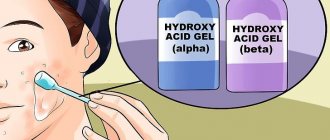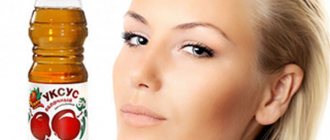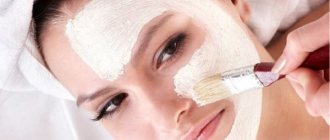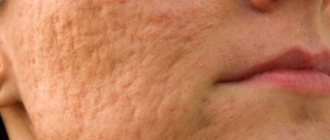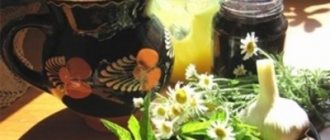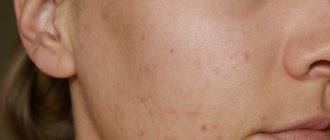Hello! If you don't know how to remove acne marks or simply even out the skin on your face, don't despair.
Especially for this, there are a lot of different natural and not so natural methods that will definitely help you cope with this problem. 
One day I asked my subscribers to send me recipes for proven products that helped them solve this issue - how to get rid of acne marks and make the skin clean and smooth.
I received a lot of answers and today I share them with you.
You can fight acne scars using professional methods (chemical peeling, ultrasonic peeling, laser cleaning), medications (Skinoren, Mederma, vitamin C) and home remedies.
I will dwell on the latter in more detail.
How to even out facial skin after acne
Different types of scarring and facial topography, as well as uneven facial tone, can develop depending on the severity of cystic acne. Scars and cicatrices are two types of acne scars that many people find embarrassing and need to be smoothed out.
Treatment for severe acne scars consists of punching, trimming, laser resurfacing, dermabrasion, dermaplaning, and chemical peel techniques. These can be performed as a single procedure or in combination with each other.
These procedures can be quite expensive, but can provide fairly quick results in evening out facial skin after acne. Although these are the best treatments for deep scars, they are not guaranteed to remove all scars and completely even out the complexion.
Let's look at each of these methods separately and choose the best and safest method for smoothing facial skin after acne:
Removal by perforation
Poll: When did your acne appear? (Number of votes: 4295)
I've been suffering all my life
It's been a couple of years now
About a few months
Recently
To vote, click on the desired answer. results
The punch removal procedure appears to be the best way to treat any type of acne scars, cicatrices or bumps. It involves the use of a small punching tool. This tool is often described as a tiny round device for processing pieces of liver. It removes or cuts out the scar from the skin. Once the scar is removed, the skin is sutured to close the wound on the face.
Typically, this treatment will leave a small scar that is significantly less noticeable than the original facial scar. There is a chance that this scar will fade over time. If a scar still remains over time or faster results are desired, a gentler resurfacing procedure may be pursued , such as laser facial treatment or microdermabrasion.
Recommendations for further skin care
To prevent the appearance of new scars, it is important to take preventive measures:
- Healthy food;
- keep your face clean;
- treat acne in a timely manner and prevent the spread of the inflammatory process;
- do not crush pimples until they are fully ripe, and do not injure the skin with your nails;
- For extensive rashes, seek treatment from specialists.
Acne brings a lot of trouble to everyone, but it goes away over time, and the marks from it are a real problem, which is very difficult to get rid of. Therefore, those who are planning to open war on scars and post-acne should be patient and slowly but surely move towards their victory over them.
source
Smoothing of facial skin after acne and skin transplantation
In this procedure, scar tissue is removed in the same way and a skin graft can be used to fill the void.
The graft can be taken from anywhere on the body, but it is usually taken from a less visible spot behind the ear. A slightly noticeable scar may still remain after the graft because the pigment of the skin where the graft is taken may be slightly different from the pigment in the skin site it is replacing These scars can also be removed or softened with a gentler resurfacing procedure.
When removing a perforation cut, only the base of the scar is removed. The doctor uses this base to fill a hole or gap in the surface of the skin. He essentially lifts up the underlying tissue and uses it to fill or replace the surface of the skin.
This base tissue is then attached to the surrounding sheath with sutures, sterile strips, or adhesive skin such as Dermabond. Unlike the removal, perforation, and grafting procedure, the skin from this procedure should have the same tone and texture as the surrounding tissue.
Laser resurfacing
This procedure, also known as laser resurfacing, laser vaporization or lasabrasion, is designed to remove scars and scars and smooth out acne skin. This procedure uses a laser that emits short intense pulses of light to vaporize a layer of skin. The doctor determines the amount of energy transferred onto the surface of the skin with a laser beam, and controls the depth of penetration. The laser can be used on the entire surface or in other specific areas of the body.
There are two types of laser resurfacing: ablative and non-ablative. The non-ablative type offers much deeper treatment for more complex irregularities and scars on the face. The ablative type of treatment will be discussed for better skin conditions and treatments for acne and pimple scars.
Non-ablative laser resurfacing uses an intense yellow beam to gently stimulate the production of new collagen, bypassing the outer layer of skin. This stimulated collagen growth is an attempt to restore normal skin cells from the inside, hoping to improve the appearance and even out the appearance of acne-prone facial skin.
This procedure uses newer, gentler laser technology that does not remove skin and is non-invasive As a result, minimal recovery time is required The procedure can be performed as an outpatient treatment for the patient during your lunch break if you really wish to Non-ablative laser therapy is usually requires a series of treatments to achieve maximum benefit.
Whitening with apple cider vinegar
The brightening properties of vinegar have long been successfully used by women. When preparing the product, you should use only table vinegar, the concentration of which does not exceed 9%. You cannot add concentrated essence. It can cause skin burns.
To lighten stains, prepare a frozen vinegar solution. 1 tbsp. l. substances are mixed with 3 tbsp. l. water. The solution is poured into ice cube trays and frozen. Rub the cubes onto your face several times a day. If the solution does not help get rid of some particularly stubborn stains, you need to make vinegar applications. Gauze folded in several layers is dipped in a vinegar solution and applied to the dark spots for 5 minutes. You need to whiten your skin every other day.
Strawberries improve complexion
Dermabrasion
The surgeon uses a motorized hand-held device to remove the outermost layers of skin. The device may use either a rough wire brush or a rough-surface attachment similar to heavy sandpaper. The doctor continues to scrape away layers of skin until the complete process of smoothing out the acne skin is achieved.
This procedure uses a hand-held instrument called a dermatome, like an electric razor. The dermatome has an oscillating blade that moves the razor to evenly cut the surface layer of skin that surrounds craters or other facial imperfections. This cutting continues until the lowest point of the scars is acne will not become smoother.
Soft tissue augmentation
This procedure is used to correct damaged skin where atrophic scars are common. The scarred area is filled with a specific substance, usually collagen or fat, which is used to raise the scarred skin to the level of the surface of healthy skin. Other filler substances that can be used are isolagens, fascia, restylane , artecoll, aquamide and alloderm Currently, this procedure needs to be repeated every 6 to 10 months. Research is currently being conducted to find a substance that can be used for a permanent solution.
Deep chemical peeling
This procedure can also be called a phenol treatment. It is a non-surgical cosmetic procedure that can significantly improve the aesthetic appearance of the skin. As its name suggests, a deep chemical peel penetrates into the deeper layers of the skin to correct damage and imperfections.
Unlike other milder chemical peels, only one chemical peel treatment is required to smooth out acne-prone facial skin. However, the recovery time will take much longer for this skin and it can be very uncomfortable in terms of pain for people with more Dark skin or a large number of freckles are not advisable to undergo a deep chemical peel procedure as there may be a noticeable difference between the treated and untreated areas. This peeling can also cause the skin to become permanently pale with an inability to tan, and it can cause uneven skin pigmentation.
Causes
Usually the problem lies in enlarged pores, and this is inherited or occurs as a result of a malfunction of the sebaceous glands.
People with oily skin types suffer more often. Increased sweating and the use of foundation significantly aggravate the situation. As a result, a person develops a new problem - acne.
In addition, unevenness appears due to the presence of purulent acne. If a person engages in physical activity, the sebaceous glands begin to function more actively, and the pores expand even more.
But much more often, a person himself provokes the appearance of bumps on the skin by squeezing out existing pimples.
It is important for women to take into account that ulcers also give unevenness.
They are aggravated by the use of cosmetics, which, on the one hand, hide imperfections, but at the same time clog already vulnerable pores.
Methods for smoothing the skin on the forehead after acne
If you are interested in effective ways to get rid of acne scars and smooth out the skin on your forehead as well, then you should check out the following few treatments for facial acne scars. They consist of ablative laser resurfacing, microdermal abrasion, and chemical peels.
You can get these types of treatments from a plastic surgeon, dermatologist, or certified esthetician. As I mentioned earlier, treatment from an esthetician will be much more affordable, and there are some highly trained and experienced estheticians offering these services.
Let's look at each of these methods:
Ablative laser resurfacing
CO2 and erbium lasers are two types of lasers used for ablative laser resurfacing. These lasers are typically used to vaporize only the top layer of skin.
A carbon dioxide laser allows the doctor to focus and adjust an intense beam onto a selected area of skin. Treatment is usually very effective, but the recovery time is about two months.
Erbium laser emits light that is designed to be absorbed by water when the light hits the skin Skin cells are mostly made up of water so the heat from the laser is evenly distributed throughout the skin Erbium laser treatment is preferred over CO2 because it is more precise and has a recovery time from treatment Typically takes less than a week Erbium laser resurfacing is also better suited for treating dark skin as it is less likely to cause hypopigmentation or lightening of the skin.
Microdermabrasion
Microdermabrasion is a procedure in which aluminum oxide crystals are sprayed onto the surface of the skin while a vacuum suction is created, which produces a gentle abrasion or polishing of the skin's surface while removing dead skin cells.
This procedure gently abrades the very surface layer of the skin and softens and brightens the appearance of the treated skin. Microdermabrasion usually needs to be repeated in a series of treatments to achieve best results.
Chemical peeling
For this procedure, a chemical solution is used to remove the damaged outer layers of dead skin cells from the surface of the skin and stimulate the cell's regenerative process. There are different types of these chemical peels. Most of them include either a solution of glycolic acid or salicylic acid, which can be used for different levels of acne damage.
This treatment will improve skin texture and tone, hydrate the skin, reduce pore size, clear blemishes, and help balance oil production to ensure an overall healthy appearance of the skin. Unlike a deep chemical peel, this treatment is superficial. It does not penetrate beyond the epidermis or papillary dermis layer of the skin. This type of chemical peel is usually offered in a series of treatments.
Conclusion: today there are quite a lot of ways to smooth out facial skin after acne, both on the forehead and on the face. The most effective and best of which are chemical peeling methods, removal of perforations and skin grafting procedures on the face. You should only determine the procedure that is suitable for you personally with your attending physician - a dermatologist or cosmetologist, considering all the pros and cons of each individual treatment method.
TOP 5 groups of ready-made funds
Daily skin care involves the use of professional cosmetics. It should be selected taking into account the individual characteristics of the body.
It is necessary to select creams, lotions, tonics and other products taking into account the individual characteristics of the skin. So, for a combination face type, you should not use products for dry skin or vice versa.
But what cosmetic products will help in the fight against acne marks? Here is a list of effective means:
- Creams and serums with retinoids contain derivatives of vitamin A. It stimulates the production of the body's own collagen and elastin, and also protects healthy cells from damage. Cosmetics with retinoids can reduce the number of scar changes.
- Tonics and lotions with glycolic and salicylic acid are irritating. They stimulate blood circulation in selected areas of the skin, which evens out the tone and reduces scars. However, these drugs should be used with caution - their excessive use leads to dry skin and the appearance of rashes.
- Lightening creams help reduce the number of age spots. They should be used with caution on people with dark and dark skin tones to avoid the appearance of areas of depigmentation.
- Cortisone creams. These products reduce the inflammatory process and prevent the formation of age spots. The cream is applied exclusively to the affected areas. The use of hydrocortisone must be discussed with your doctor. Treatment is carried out in courses - no more than 21 days with breaks of 3 months.
- Silicone based creams. Allows you to reduce the number of raised scars. To achieve the effect, the products must be used systematically for several months.
After acne disappears, it is very important to prevent the appearance of age spots. They occur especially often under the influence of sunlight and ultraviolet rays.
Therefore, cosmetologists recommend limiting sun exposure and avoiding visiting solariums.
Patients have different types of scars. A thorough examination by a dermatologist will help you choose the appropriate treatment method. Home care alone is not enough. It will not help remove deep scars.
Dermatologist Davin Lim
During the period of fighting acne, it is necessary to apply protective creams marked SPF to the face - they protect the skin from exposure to ultraviolet radiation. They must be used even in winter, when the sun shines brightly.
You should also use lightening masks weekly at home. Having an irritating effect, they stimulate blood flow to all areas of the face, thereby evening out the natural color.
To achieve the desired effect, you must choose exclusively professional cosmetics. It is best to order products individually from a cosmetologist.
Cheap products do not contain a sufficient amount of active particles and are ineffective in combating facial changes after acne.
